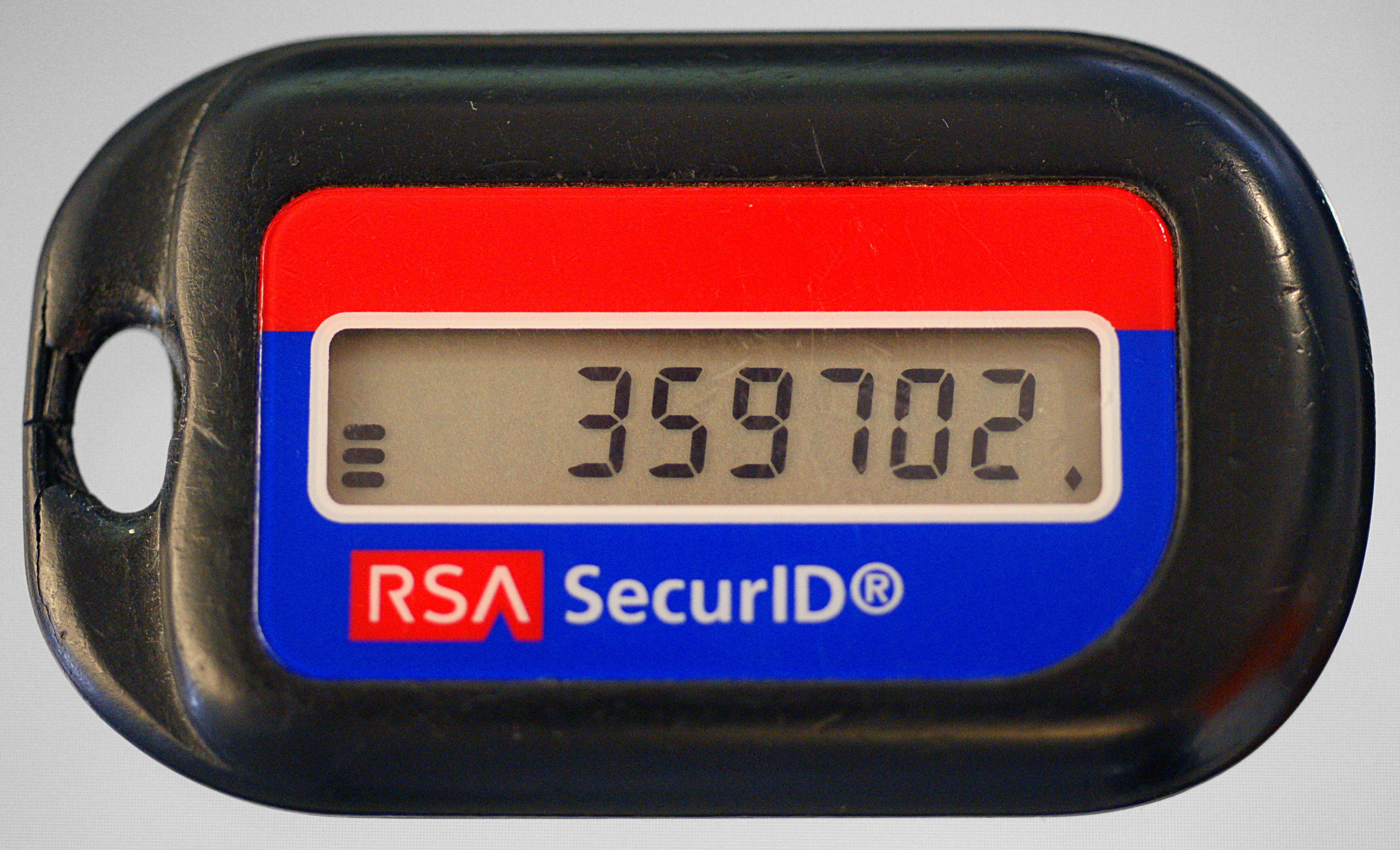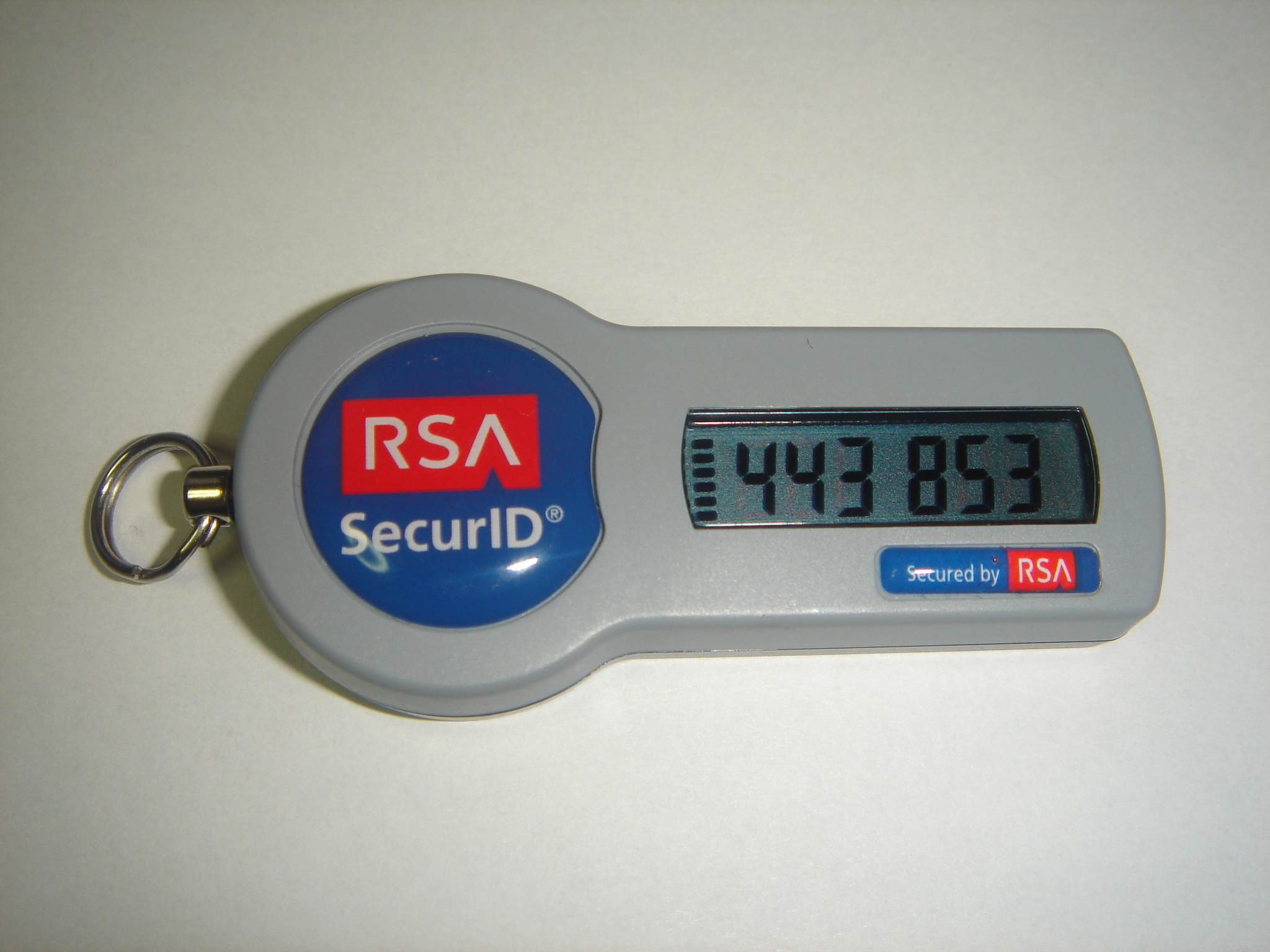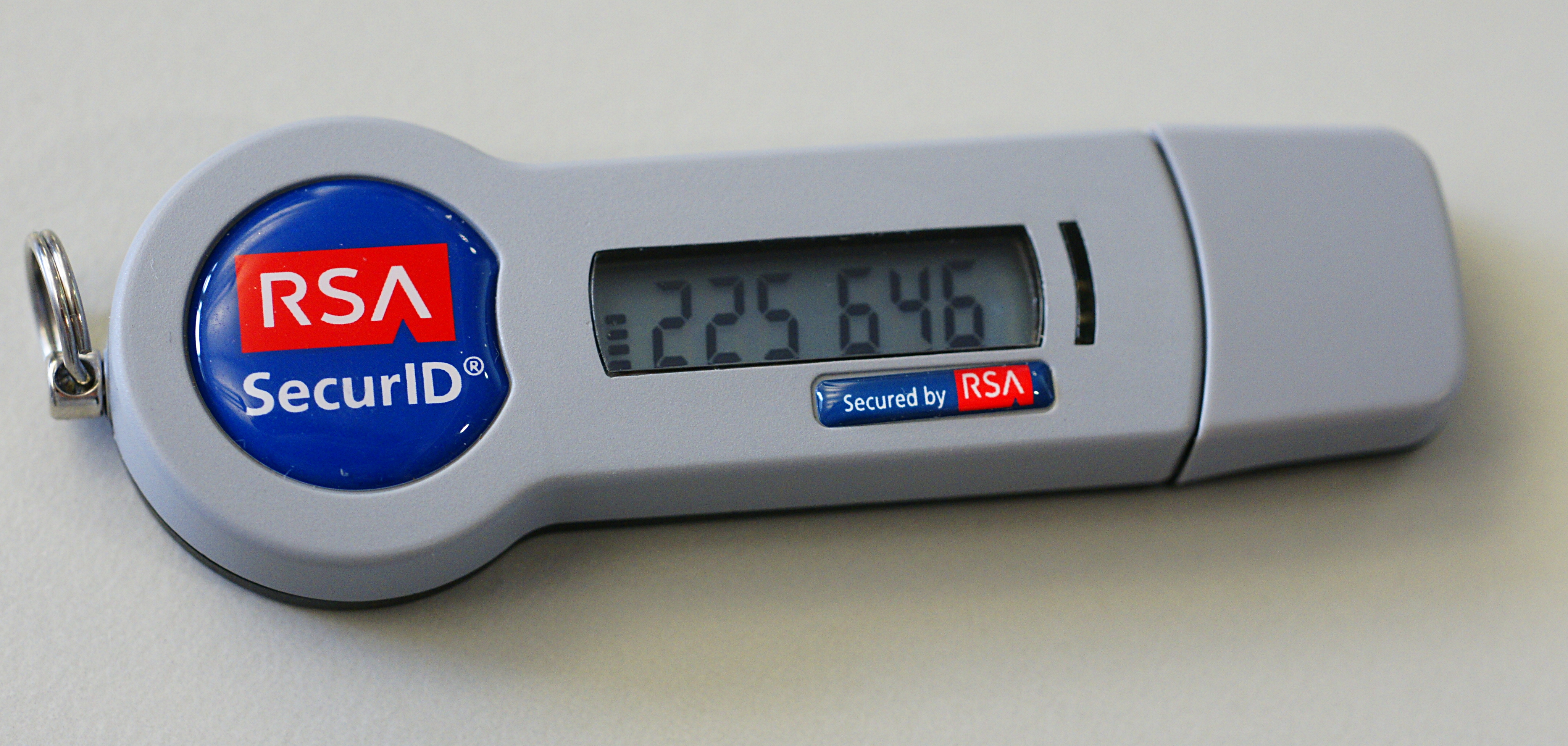SecurID on:
[Wikipedia]
[Google]
[Amazon]
RSA SecurID, formerly referred to as SecurID, is a mechanism developed by RSA for performing


 The RSA SecurID authentication mechanism consists of a " token"—either hardware (e.g. a
The RSA SecurID authentication mechanism consists of a " token"—either hardware (e.g. a
Official RSA SecurID website
;Technical details
Sample SecurID Token Emulator with token Secret Import
I.C.Wiener, Bugtraq post.
Adam Shostack, 1996.
Usenet thread discussing new SecurID details
Vin McLellan, et al., ''comp.security.misc''.
Unofficial SecurID information and some reverse-engineering attempts
Yahoo Groups ''securid-users''.
Analysis of possible risks from 2011 compromise
;Published attacks against the SecurID hash function
Cryptanalysis of the Alleged SecurID Hash Function
(PDF)
Improved Cryptanalysis of SecurID
(PDF) Scott Contini and Yiqun Lisa Yin.
Fast Software-Based Attacks on SecurID
(PDF) Scott Contini and Yiqun Lisa Yin. {{DEFAULTSORT:Securid Computer security hardware EMC Corporation Password authentication
two-factor authentication
Multi-factor authentication (MFA; two-factor authentication, or 2FA) is an electronic authentication method in which a user is granted access to a website or Application software, application only after successfully presenting two or more distin ...
for a user to a network resource.
Description

 The RSA SecurID authentication mechanism consists of a " token"—either hardware (e.g. a
The RSA SecurID authentication mechanism consists of a " token"—either hardware (e.g. a key fob
A keychain () (also keyring) is a small ring or chain of metal to which several keys, or fobs can be attached. The terms keyring and keychain are often used interchangeably to mean both the individual ring, or a combined unit of a ring and fob ...
) or software (a soft token)—which is assigned to a computer user and which creates an authentication code at fixed intervals (usually 60 seconds) using a built-in clock and the card's factory-encoded almost random key (known as the "seed"). The seed is different for each token, and is loaded into the corresponding RSA SecurID server (RSA Authentication Manager, formerly ACE/Server) as the tokens are purchased. On-demand tokens are also available, which provide a tokencode via email or SMS delivery, eliminating the need to provision a token to the user.
The token hardware is designed to be tamper-resistant to deter reverse engineering
Reverse engineering (also known as backwards engineering or back engineering) is a process or method through which one attempts to understand through deductive reasoning how a previously made device, process, system, or piece of software accompl ...
. When software implementations of the same algorithm ("software tokens") appeared on the market, public code had been developed by the security community allowing a user to emulate RSA SecurID in software, but only if they have access to a current RSA SecurID code, and the original 64-bit RSA SecurID seed file introduced to the server. Later, the 128-bit RSA SecurID algorithm was published as part of an open source library. In the RSA SecurID authentication scheme, the seed record is the secret key used to generate one-time password
A one-time password (OTP), also known as a one-time PIN, one-time passcode, one-time authorization code (OTAC) or dynamic password, is a password that is valid for only one login session or transaction, on a computer system or other digital dev ...
s. Newer versions also feature a USB connector, which allows the token to be used as a smart card
A smart card (SC), chip card, or integrated circuit card (ICC or IC card), is a card used to control access to a resource. It is typically a plastic credit card-sized card with an Embedded system, embedded integrated circuit (IC) chip. Many smart ...
-like device for securely storing certificates.
A user authenticating to a network resource—say, a dial-in server or a firewall—needs to enter both a personal identification number
A personal identification number (PIN; sometimes RAS syndrome, redundantly a PIN code or PIN number) is a numeric (sometimes alpha-numeric) passcode used in the process of authenticating a user accessing a system.
The PIN has been the key to faci ...
and the number being displayed ''at that moment'' on their RSA SecurID token. Though increasingly rare, some systems using RSA SecurID disregard PIN implementation altogether, and rely on password/RSA SecurID code combinations. The server, which also has a real-time clock and a database of valid cards with the associated seed records, authenticates a user by computing what number the token is supposed to be showing at that moment in time and checking this against what the user entered.
On older versions of SecurID, a "duress PIN" may be used—an alternate code which creates a security event log showing that a user was forced to enter their PIN, while still providing transparent authentication. Using the duress PIN would allow one successful authentication, after which the token will automatically be disabled. The "duress PIN" feature has been deprecated and is not available on currently supported versions.
While the RSA SecurID system adds a layer of security to a network, difficulty can occur if the authentication server's clock becomes out of sync with the clock built into the authentication tokens. Normal token clock drift is accounted for automatically by the server by adjusting a stored "drift" value over time. If the out of sync condition is not a result of normal hardware token clock drift, correcting the synchronization of the Authentication Manager server clock with the out of sync token (or tokens) can be accomplished in several different ways. If the server clock had drifted and the administrator made a change to the system clock, the tokens can either be resynchronized one-by-one, or the stored drift values adjusted manually. The drift can be done on individual tokens or in bulk using a command line utility.
RSA Security has pushed forth an initiative called "Ubiquitous Authentication", partnering with device manufacturers such as IronKey, SanDisk, Motorola
Motorola, Inc. () was an American multinational telecommunications company based in Schaumburg, Illinois. It was founded by brothers Paul and Joseph Galvin in 1928 and had been named Motorola since 1947. Many of Motorola's products had been ...
, Freescale Semiconductor
Freescale Semiconductor, Inc. was an American semiconductor manufacturer. It was created by the divestiture of the Semiconductor Products Sector of Motorola in 2004. Freescale focused their integrated circuit products on the automotive, embedde ...
, Redcannon, Broadcom
Broadcom Inc. is an American multinational corporation, multinational designer, developer, manufacturer, and global supplier of a wide range of semiconductor and infrastructure software products. Broadcom's product offerings serve the data cen ...
, and BlackBerry
BlackBerry is a discontinued brand of handheld devices and related mobile services, originally developed and maintained by the Canadian company Research In Motion (RIM, later known as BlackBerry Limited) until 2016. The first BlackBerry device ...
to embed the SecurID software into everyday devices such as USB flash drives and cell phones, to reduce cost and the number of objects that the user must carry.
Theoretical vulnerabilities
Token codes are easily stolen, because no mutual-authentication exists (anything that can steal a password can also steal a token code). This is significant, since it is the principal threat most users believe they are solving with this technology. The simplest practical vulnerability with any password container is losing the special key device or the activated smart phone with the integrated key function. Such vulnerability cannot be healed with any single token container device within the preset time span of activation. All further consideration presumes loss prevention, e.g. by additional electronic leash or body sensor and alarm. While RSA SecurID tokens offer a level of protection against passwordreplay attack
A replay attack (also known as a repeat attack or playback attack) is a form of network attack in which valid data transmission is maliciously or fraudulently repeated or delayed. This is carried out either by the originator or by an adversary w ...
s, they are not designed to offer protection against man in the middle type attacks when used alone. If the attacker manages to block the authorized user from authenticating to the server until the next token code will be valid, they will be able to log into the server. Risk-based analytics (RBA), a new feature in the latest version (8.0) provides significant protection against this type of attack if the user is enabled and authenticating on an agent enabled for RBA. RSA SecurID does not prevent man in the browser (MitB) based attacks.
SecurID authentication server tries to prevent password sniffing and simultaneous login by declining both authentication requests, if two valid credentials are presented within a given time frame. This has been documented in an unverified post by John G. Brainard. If the attacker removes from the user the ability to authenticate however, the SecurID server will assume that it is the user who is actually authenticating and hence will allow the attacker's authentication through. Under this attack model, the system security can be improved using encryption/authentication mechanisms such as SSL.
Although soft tokens may be more convenient, critics indicate that the tamper-resistant property of hard tokens is unmatched in soft token implementations, which could allow seed record secret keys to be duplicated and user impersonation to occur.
Hard tokens, on the other hand, can be physically stolen (or acquired via social engineering) from end users. The small form factor makes hard token theft much more viable than laptop/desktop scanning. A user will typically wait more than one day before reporting the device as missing, giving the attacker plenty of time to breach the unprotected system. This could only occur, however, if the user's UserID and PIN are also known. Risk-based analytics can provide additional protection against the use of lost or stolen tokens, even if the user's UserID and PIN are known by the attackers.
Batteries go flat periodically, requiring complicated replacement and re-enrollment procedures.
Reception and competing products
As of 2003, RSA SecurID commanded over 70% of the two-factor authentication market and 25 million devices have been produced to date. A number of competitors, such as VASCO, make similarsecurity token
A security token is a peripheral device used to gain access to an electronically restricted resource. The token is used in addition to, or in place of, a password. Examples of security tokens include wireless key cards used to open locked door ...
s, mostly based on the open OATH HOTP standard. A study on OTP published by Gartner
Gartner, Inc. is an American research and advisory firm focusing on business and technology topics. Gartner provides its products and services through research reports, conferences, and consulting. Its clients include large corporations, gover ...
in 2010 mentions OATH and SecurID as the only competitors.
Other network authentication systems, such as OPIE and S/Key
S/KEY is a one-time password system developed for authentication to Unix-like operating systems, especially from dumb terminals or untrusted public computers on which one does not want to type a long-term password. A user's real password is combine ...
(sometimes more generally known as OTP, as S/Key is a trademark of Telcordia Technologies
iconectiv supplies communications providers with network planning and management services. The company’s cloud-based information as a service network and operations management and numbering solutions span trusted communications, digital identi ...
, formerly Bellcore
iconectiv supplies communications providers with network planning and management services. The company’s cloud-based information as a service network and operations management and numbering solutions span trusted communications, digital identi ...
) attempt to provide the "something you have" level of authentication without requiring a hardware token.
March 2011 system compromise
On 17 March 2011, RSA announced that they had been victims of "an extremely sophisticated cyber attack". Concerns were raised specifically in reference to the SecurID system, saying that "this information could potentially be used to reduce the effectiveness of a current two-factor authentication implementation". However, their formalForm 8-K
Form 8-K is a very broad form used to notify investors in United States public companies of specified events that may be important to shareholders or the United States Securities and Exchange Commission. This is one of the most common types of for ...
submission indicated that they did not believe the breach would have a "material impact on its financial results". The breach cost EMC, the parent company of RSA, $66.3 million, which was taken as a charge against second quarter earnings. It covered costs to investigate the attack, harden its IT systems and monitor transactions of corporate customers, according to EMC Executive Vice President and Chief Financial Officer David Goulden, in a conference call with analysts.
The breach into RSA's network was carried out by hackers who sent phishing
Phishing is a form of social engineering and a scam where attackers deceive people into revealing sensitive information or installing malware such as viruses, worms, adware, or ransomware. Phishing attacks have become increasingly sophisticate ...
emails to two targeted, small groups of employees of RSA. Attached to the email was a Microsoft Excel
Microsoft Excel is a spreadsheet editor developed by Microsoft for Microsoft Windows, Windows, macOS, Android (operating system), Android, iOS and iPadOS. It features calculation or computation capabilities, graphing tools, pivot tables, and a ...
file containing malware
Malware (a portmanteau of ''malicious software'')Tahir, R. (2018)A study on malware and malware detection techniques . ''International Journal of Education and Management Engineering'', ''8''(2), 20. is any software intentionally designed to caus ...
. When an RSA employee opened the Excel file, the malware exploited a vulnerability in Adobe Flash
Adobe Flash (formerly Macromedia Flash and FutureSplash) is a mostly discontinuedAlthough it is discontinued by Adobe Inc., for the Chinese market it is developed by Zhongcheng and for the international enterprise market it is developed by Ha ...
. The exploit allowed the hackers to use the Poison Ivy
Poison ivy is a type of allergenic plant in the genus '' Toxicodendron'' native to Asia and North America. Formerly considered a single species, '' Toxicodendron radicans'', poison ivies are now generally treated as a complex of three separate s ...
RAT
Rats are various medium-sized, long-tailed rodents. Species of rats are found throughout the order Rodentia, but stereotypical rats are found in the genus ''Rattus''. Other rat genera include '' Neotoma'' (pack rats), '' Bandicota'' (bandicoo ...
to gain control of machines and access servers in RSA's network.
There are some hints that the breach involved the theft of RSA's database mapping token serial numbers to the secret token "seeds" that were injected to make each one unique. Reports of RSA executives telling customers to "ensure that they protect the serial numbers on their tokens" lend credibility to this hypothesis.
RSA stated it did not release details about the extent of the attack so as to not give potential attackers information they could use in figuring out how to attack the system.
On 6 June 2011, RSA offered token replacements or free security monitoring services to any of its more than 30,000 SecurID customers, following an attempted cyber breach on defense customer Lockheed Martin
The Lockheed Martin Corporation is an American Arms industry, defense and aerospace manufacturer with worldwide interests. It was formed by the merger of Lockheed Corporation with Martin Marietta on March 15, 1995. It is headquartered in North ...
that appeared to be related to the SecurID information stolen from RSA. In spite of the resulting attack on one of its defense customers, company chairman Art Coviello said that "We believe and still believe that the customers are protected".
Resulting attacks
In April 2011, unconfirmed rumors citedL-3 Communications
L3 Technologies, formerly L-3 Communications Holdings, was an American company that supplied command and control, communications, intelligence, surveillance and reconnaissance ( C3ISR) systems and products, avionics, ocean products, training ...
as having been attacked as a result of the RSA compromise.
In May 2011, this information was used to attack Lockheed Martin
The Lockheed Martin Corporation is an American Arms industry, defense and aerospace manufacturer with worldwide interests. It was formed by the merger of Lockheed Corporation with Martin Marietta on March 15, 1995. It is headquartered in North ...
systems. However Lockheed Martin claims that due to "aggressive actions" by the company's information security
Information security is the practice of protecting information by mitigating information risks. It is part of information risk management. It typically involves preventing or reducing the probability of unauthorized or inappropriate access to data ...
team, "No customer, program or employee personal data" was compromised by this "significant and tenacious attack". The Department of Homeland Security
The United States Department of Homeland Security (DHS) is the U.S. federal executive department responsible for public security, roughly comparable to the interior, home, or public security ministries in other countries. Its missions invol ...
and the US Defense Department
The United States Department of Defense (DoD, USDOD, or DOD) is an executive department of the U.S. federal government charged with coordinating and supervising the six U.S. armed services: the Army, Navy, Marines, Air Force, Space Force, t ...
offered help to determine the scope of the attack.
References
External links
Official RSA SecurID website
;Technical details
Sample SecurID Token Emulator with token Secret Import
I.C.Wiener, Bugtraq post.
Adam Shostack, 1996.
Usenet thread discussing new SecurID details
Vin McLellan, et al., ''comp.security.misc''.
Unofficial SecurID information and some reverse-engineering attempts
Yahoo Groups ''securid-users''.
Analysis of possible risks from 2011 compromise
;Published attacks against the SecurID hash function
Cryptanalysis of the Alleged SecurID Hash Function
(PDF)
Alex Biryukov
Alex Biryukov () is a cryptographer, currently a full professor at the University of Luxembourg.
Biography
His notable work includes the design of the stream cipher LEX, as well as the cryptanalysis of numerous cryptographic primitives. In 1998, ...
, Joseph Lano, and Bart Preneel
Bart Preneel (born 15 October 1963 in Leuven, Belgium) is a Belgium, Belgian cryptographer and cryptanalyst. He is a professor at Katholieke Universiteit Leuven, in the COSIC group.
He was the president of the International Association for Crypt ...
.
Improved Cryptanalysis of SecurID
(PDF) Scott Contini and Yiqun Lisa Yin.
Fast Software-Based Attacks on SecurID
(PDF) Scott Contini and Yiqun Lisa Yin. {{DEFAULTSORT:Securid Computer security hardware EMC Corporation Password authentication